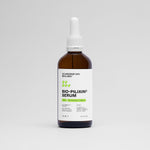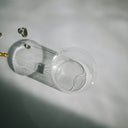Bleaching hair is a popular way to achieve bold, vibrant colors or a striking platinum look. However, this chemical process comes with risks, and many people wonder about its long-term effects on hair health. If you’ve noticed breakage or shedding after bleaching, you might be asking: Can bleaching hair cause hair loss? The answer is yes—bleaching can weaken hair structure, leading to breakage and temporary hair loss. In this article, we’ll explore how bleaching damages hair, why it can result in hair loss, and how to minimize harm while achieving your desired color.
Table of content
Can Bleaching Hair Cause Hair Loss?
Yes, bleaching hair can cause hair loss. The chemicals in bleach, particularly ammonia and hydrogen peroxide, strip away the hair’s natural pigment and weaken its protein structure. This damage can make hair brittle, prone to breakage, and more likely to fall out. While bleaching doesn’t typically destroy hair follicles (which are responsible for regrowth), severe damage can lead to temporary hair loss due to snapped strands or scalp irritation.
How Bleaching Works
Bleaching involves using chemical agents to lighten hair by breaking down its natural melanin (pigment). The process typically includes:
- Ammonia: Opens the hair cuticle to allow bleach to penetrate.
- Hydrogen Peroxide: Oxidizes melanin, removing color from the hair shaft.
While effective for lightening hair, these chemicals disrupt the hair’s natural integrity, leading to structural damage.
How Bleaching Causes Hair Damage and Loss
Hair loss from bleaching is usually due to physical damage rather than follicle destruction. Here’s how the process contributes to breakage and shedding:
1. Cuticle Damage
The hair cuticle is the outermost protective layer of the hair shaft. Bleach lifts and roughens the cuticle, leaving the inner cortex exposed. This makes hair more vulnerable to friction, heat, and environmental stressors, leading to split ends and breakage.
2. Protein Loss
Hair is primarily made of keratin, a structural protein. Bleach breaks down the disulfide bonds in keratin, weakening the hair’s strength and elasticity. Over-bleached hair can become gummy, stretchy, or snap easily.
3. Moisture Depletion
Bleaching strips natural oils and moisture from the hair, leaving it dry and brittle. Dehydrated hair is more prone to tangling and breakage, which can mimic hair loss.
4. Scalp Irritation
If bleach comes into contact with the scalp, it can cause chemical burns, inflammation, or allergic reactions. Severe irritation may damage hair follicles, leading to temporary shedding (telogen effluvium).
Is Bleaching-Related Hair Loss Permanent?
Most hair loss caused by bleaching is temporary and stems from breakage rather than follicle damage. However, repeated or improper bleaching can cause cumulative harm, making hair increasingly fragile. If the scalp is burned or scarred, follicle damage may result in permanent hair loss in affected areas.
Factors That Influence Bleaching Damage
Not everyone experiences the same level of damage from bleaching. Key factors include:
1. Natural Hair Color and Texture
Darker hair requires more bleaching sessions to achieve lighter shades, increasing the risk of damage. Coarse or curly hair may also be more prone to dryness post-bleaching.
2. Previous Chemical Treatments
Hair that has been previously colored, permed, or relaxed is already weakened and more susceptible to breakage during bleaching.
3. Application Technique
Leaving bleach on too long, overlapping applications on previously bleached sections, or using high-volume developers (e.g., 40-volume peroxide) can exacerbate damage.
4. Aftercare Routine
Failing to moisturize and protect bleached hair can accelerate breakage and dryness.
How to Minimize Hair Damage While Bleaching
If you choose to bleach your hair, follow these tips to reduce the risk of hair loss:
1. Prep Hair Before Bleaching
- Avoid washing hair for 2–3 days before bleaching to let natural oils protect the scalp.
- Use a deep conditioning treatment a week prior to strengthen hair.
2. Seek Professional Help
A skilled stylist can assess your hair’s condition, choose the right products, and apply bleach evenly to minimize damage.
3. Avoid Overlapping
Only apply bleach to new growth during touch-ups to prevent over-processing previously lightened sections.
4. Use a Lower-Volume Developer
Opt for a 20- or 30-volume developer instead of 40-volume to lighten hair more gently, especially for at-home treatments.
5. Deep Condition Regularly
After bleaching, use protein-rich and moisturizing masks weekly to restore strength and hydration.
6. Limit Heat Styling
Bleached hair is more vulnerable to heat damage. Use heat protectants and keep tools on low settings.
How to Repair Bleached Hair
If your hair is already damaged from bleaching, take these steps to restore its health:
1. Protein Treatments
Use products containing hydrolyzed keratin or collagen to rebuild broken bonds and strengthen hair.
2. Moisturizing Products
Look for leave-in conditioners, oils (e.g., argan, coconut), and serums to replenish lost moisture.
3. Trim Split Ends
Regular trims prevent splits from traveling up the hair shaft and causing further breakage.
4. Avoid Over-Washing
Wash hair 1–2 times a week with sulfate-free shampoos to prevent stripping natural oils.
Myths About Bleaching and Hair Loss
Let’s debunk common misconceptions:
Myth 1: “Bleaching Causes Permanent Hair Loss”
Bleaching typically causes breakage, not permanent follicle damage. Hair regrows once the scalp and follicles are healthy.
Myth 2: “All Hair Types React the Same to Bleach”
Fine, curly, or previously treated hair is more prone to damage than thick, virgin hair.
Myth 3: “Toner Prevents Damage”
Toner adjusts color but doesn’t repair damage. It’s essential to pair toning with deep conditioning.
When to See a Dermatologist
Consult a professional if you experience:
- Severe scalp burns, blistering, or infection.
- Excessive shedding beyond breakage (e.g., clumps of hair with roots).
- Allergic reactions like itching, swelling, or rashes.
Conclusion
Bleaching hair can indeed cause hair loss in the form of breakage and, in rare cases, temporary shedding due to scalp damage. While the results can be stunning, the process requires careful application and diligent aftercare to preserve hair health. By preparing your hair beforehand, seeking professional help, and prioritizing repair post-bleach, you can enjoy your new look without sacrificing the integrity of your hair. If damage occurs, focus on restorative treatments and consult a stylist or dermatologist for personalized advice.
Tired of Thinning Hair? Try a Clinically Tested Serum.
Looking for a natural way to regrow hair and achieve a thicker, fuller head of hair? Ditch the stinging nettle for hair loss – Bio-Pilixin Serum is a drug-free hair activation serum that delivers clinically tested results.
Here's why Bio-Pilixin is superior:
- Clinically Tested Results: 93% of users saw a reduction in hair loss, and 73% experienced increased hair density.
- Safe and Natural: Unlike harsh chemicals, Bio-Pilixin uses plant growth factors derived from stem cell technology to nourish hair follicles and stimulate growth.
- Fast-Acting: See visible results in as little as 45 days (most typically see results within 150 days).
Stop wasting time on unproven remedies. Bio-Pilixin is the safe, natural serum you've been searching for.
Read more:
- The 11 Best Dermatologists Recommended Shampoos To Buy In the UK (2025)
- 13 Best Shampoos For Volume To Buy in the UK (2025)
- The 7 Best Shampoo For Older Women To Buy in 2025
As your leading source for hair health information over the past 4 years, we never compromise on accuracy. When it comes to your health, you deserve information you can truly rely on - and earning your trust is our top priority.
Here's how Scandinavian Biolabs ensures every piece of content meets the highest standards of accuracy and integrity:
- Credentialed Experts: Our reviewers are actively practicing doctors and medical researchers
- Stringent Reviews: Content undergoes rigorous editing by subject specialists and review by a practicing doctor.
- Evidence-Based: We rely on well-established research from trusted scientific sources like peer-reviewed journals and health authorities.
- Full Transparency: Our editorial standards, writer credentials, reviewer credentials, correction process, and funding are all publicly documented.
- Independent Voice: While we do promote products, we operate in a vacuum to business operations. Our main goal is just an unwavering commitment to providing medically-sound guidance.
You can count on Scandinavian Biolabs to consistently deliver the trustworthy health information you deserve. Read our Editorial Standards.






